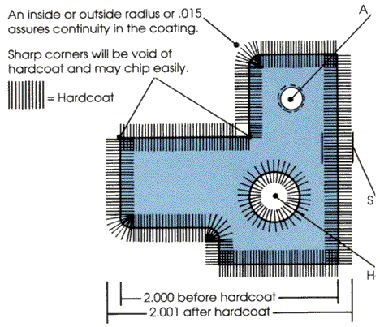GENERAL GUIDELINES
EXAMPLE: Alloy 5052 may have a max. coating thickness of 5 mils. and a black color.
EXAMPLE: Alloy 356 may have a max. coating of 10 mils. and a gray or light gray color.
*NOTE: Coatings of more than 3 1/2 mils. tend to chip and become milky in color and should only be used in the salvage of parts.
HARDNESS: Coatings are generally considered to be “file hard’. For most alloys, this is between 60 and 70 Rockwell C or between 380 to 430 VHN.
Anodic Coatings are non-conductive and offer high dielectric strength. Coatings that are 2 mils thick have breakdown voltages of 1500 to 2000 volts.
(Below Left) Under magnification, ALL Anodic coatings will exhibit fine hair-like cracks called crazing. This results from the difference in thermal expansion rated between the coating and the base metal. Crazing does not appear to be detrimental to any of the properties of the anodic coating, but it will increase the RMS about 10 to 20 micro inches.
A. All Anodic coatings will affect thread dimensions for external and internal threads; the major and minor diameter will be increased 2 times the amount of growth. The pitch diameter for threads having an included angle of 60° will increase 4 times the amount of growth. For threads having an included angle, other than 60°, the pitch diameter will increase 2 times the amount of growth divided by the sine of 1/2 the included angle.
S. .001 Coating Thickness
Note: 1/2 the coating thickness is buildup and 1/2 is penetration into the base metal.
H. This bore was .751 before hardcoat and will be .750 after hardcoat.
Try to avoid blind holes.
When sending your parts, be sure to include the following on your purchase order:
· Part Number
· Purchase Order Number
· Alloy of Parts
· Coating Thicknesses
· Racking Instructions
· Certification
· Specialization Requirements
· Masking Instructions
· Your Company Contact
· Shipping & Packing Requirements
· Number of Pieces
· Blueprint (if possible)


